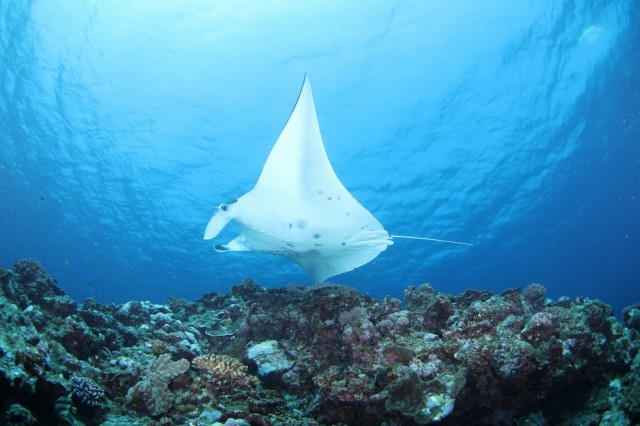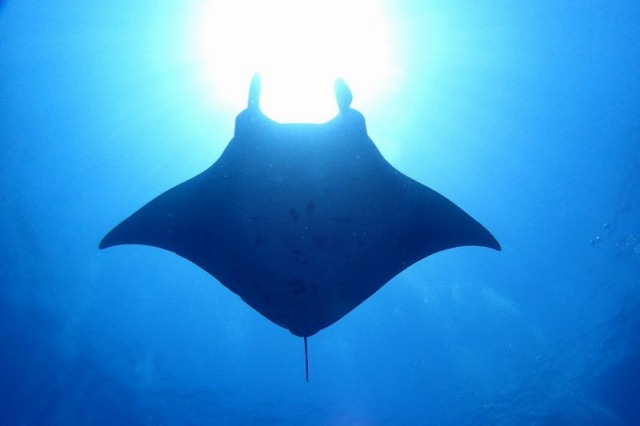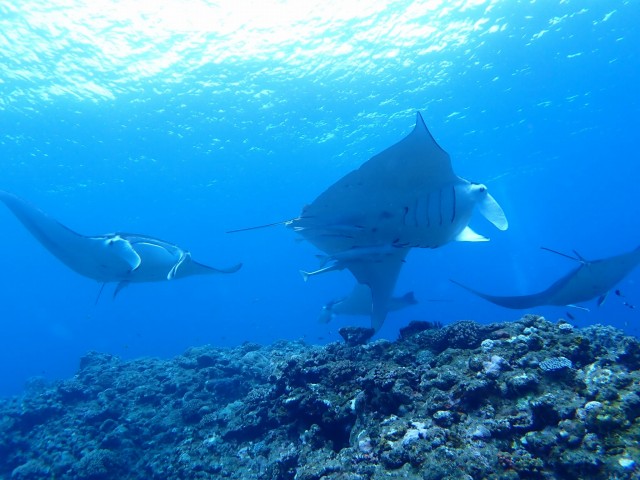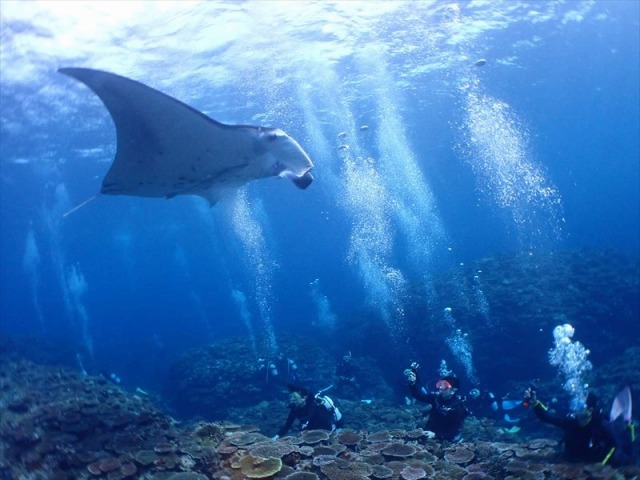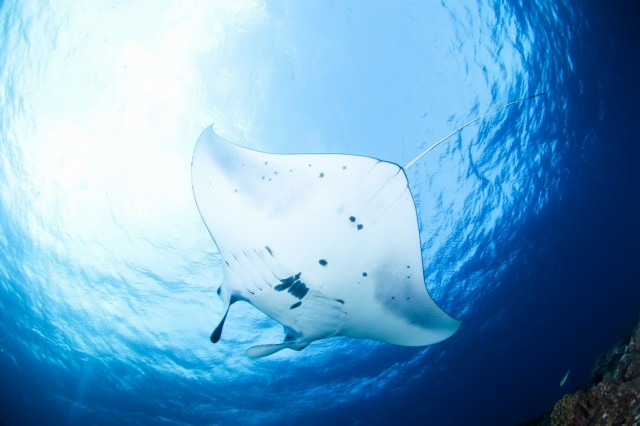Find and Book Ishigaki Island Manta Ray Tours by Type and Features
 |
 |
What is a Manta Ray?

The creatures commonly referred to as “manta rays” belong to the Mobulidae family, including species like the Giant Manta Ray (Mobula birostris) and the Reef Manta Ray (Mobula alfredi). They inhabit tropical and subtropical coral reef areas worldwide and are highly sought-after by divers and snorkelers alike.
Manta rays can grow up to 8 meters in wingspan and weigh up to 3 tons. They are often seen swimming in groups and feed on plankton while gliding through shallow waters. Despite their gentle nature, manta rays are also known for their acrobatic jumps out of the water.
Unlike stingrays, manta rays do not have venomous barbs, making them completely safe to observe up close!
Manta Rays in Ishigaki Island

While places like the Maldives, Palau, and Bali are famous for manta ray encounters, Ishigaki Island is one of the best spots in the world for seeing these majestic creatures!
The peak season for manta rays in Ishigaki is June to November, when sightings are highly likely. The species commonly found here is the Reef Manta Ray (Mobula alfredi), which can grow up to 5 meters in wingspan.
Unlike the Giant Manta Ray, which tends to roam offshore and is more commonly found around the Ogasawara Islands in Japan, Ishigaki’s Reef Manta Rays are known to hover over specific coral reef areas. These locations, called “cleaning stations”, are where small fish like cleaner wrasses remove parasites from the mantas’ bodies.
Since manta rays frequently return to these cleaning stations, Ishigaki Island offers one of the highest probabilities of manta encounters in the world!
Best Season for Manta Ray Sightings in Ishigaki
Manta rays can be seen year-round, but the best season is during the stable summer months.
From June to September, manta rays are at their most active, and the probability of encountering them is significantly high. The absolute peak is around August, when the encounter rate reaches 70–80%. Even though this period occasionally experiences typhoons, tours that manage to operate still offer the highest chance of spotting manta rays.
From October to November, the number of mantas remains high, but the weather starts to cool slightly. Conditions are still generally favorable for manta-watching.
However, from December to February, sightings decrease significantly, and the rougher sea conditions lead to a higher risk of tour cancellations. While the water temperature stays above 20°C year-round, strong winds and high waves make manta encounters less reliable during winter.
For the best experience, plan your manta tour between June and September, when both weather conditions and manta sightings are at their most favorable.
Top Manta Ray Spots in Ishigaki
The best time to encounter manta rays is around August. Even when considering the possibility of tour cancellations due to typhoons, the chances of seeing manta rays remain high at 70–80%. In other words, as long as the boat sets sail and reaches the manta spots, the likelihood of spotting these majestic creatures is at its peak.
Activities for Seeing Manta Rays in Ishigaki

1. Kabira Ishizaki Manta Scramble
Located near Kabira Bay, this world-famous manta spot has multiple cleaning stations, making sightings highly likely. The depth ranges from 10–15 meters, and the currents are mild, making it suitable for beginners.
2. Manta City
Just 300 meters southwest of Manta Scramble, Manta City is a smaller but highly reliable manta viewing spot. Unlike Manta Scramble, it has only one cleaning station, but mantas are frequently spotted here.
To protect the area, only five boats are allowed at a time, making it a less crowded and more exclusive experience.
3. Yonara Channel
This deep-water drift diving spot between Iriomote Island and Kohama Island is known as a manta ray migration route. Unlike the other locations, this area has a sandy seabed, creating a unique silhouetted view of mantas gliding above the white sands.
Since it requires drift diving, Yonara Channel is recommended for advanced divers.
Activities for Seeing Manta Rays in Ishigaki
Diving

If you want to get the closest possible view of manta rays, diving is the best choice. By staying still near coral formations, manta rays often swim directly overhead, sometimes performing mesmerizing loops!
During peak season, it’s possible to see 10–20 mantas at once (mantas are counted using “枚” in Japanese, just like paper!).
Even if you don’t have a diving license, you can still join a Beginner Diving (Introductory Diving) tour, which allows children as young as 10 years old to participate.
👉 Click here for Manta Diving Tours
Snorkeling

Snorkeling is a great option for those who prefer a more relaxed experience or for children under 10.
Since manta rays often swim in shallow waters, snorkeling tours offer an excellent chance to see them up close without needing to dive. Simply float on the surface in a life jacket and watch as these giants glide beneath you!
【Ishigaki & Kohama Island】 Manta Ray & Phantom Island Snorkeling Tour (Full-Day)

This 6.5-hour tour combines a manta snorkeling experience with a visit to the “Phantom Island” (Hama Island), a stunning sandbar that appears only during low tide.
✔ Swim with manta rays
✔ Relax on a breathtaking sandbar
✔ Perfect for beginners and families
Important Safety Tips for Manta Tours

Although manta rays are gentle, there are a few important things to keep in mind:
1. Strong Currents in Some Areas
Many manta sites are located in areas with strong currents, especially Yonara Channel. Even experienced swimmers can be carried away by the current, so always follow your guide’s instructions.
2. Deep Water & Safety Precautions
Manta rays are often found in deep waters. While snorkelers stay near the surface, divers must be cautious about not exceeding their depth limits.
Additionally, muscle cramps can occur while swimming, so it’s essential to warm up beforehand.
- Most tours accept children as young as 6 years old.
- Some tours allow infants and toddlers to join as boat passengers.
- The local guide will decide based on the latest conditions.
- If the tour is canceled due to bad weather, you can reschedule or cancel for free.

